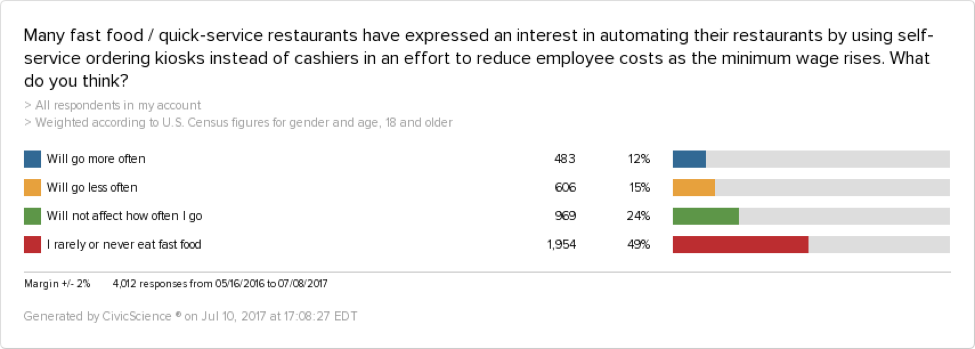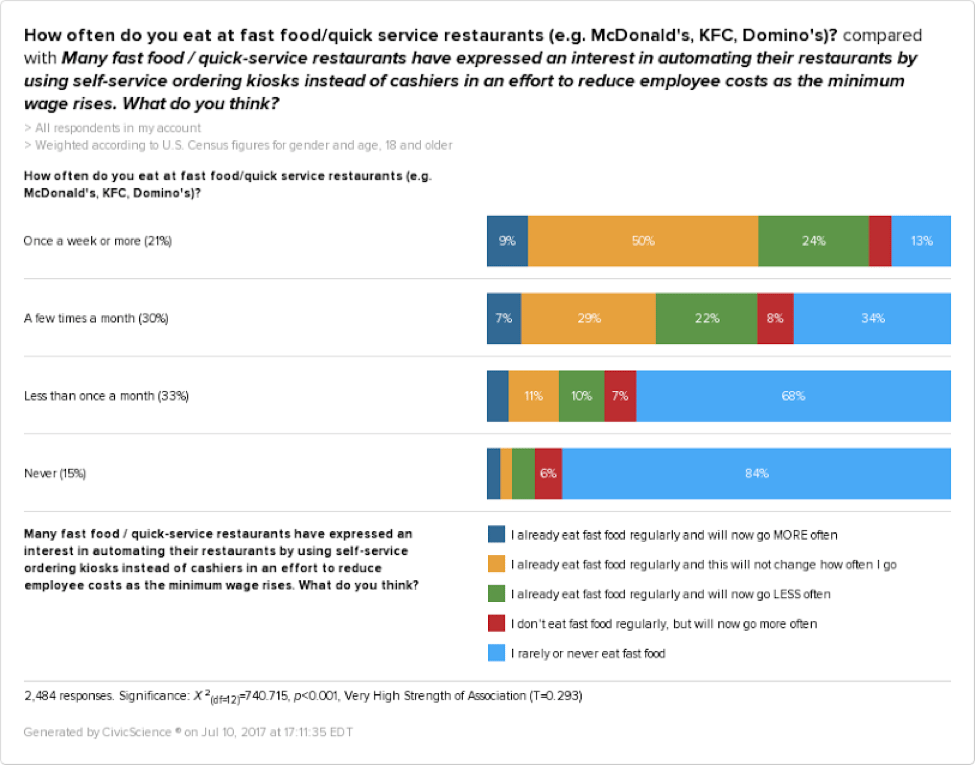The Gist: Many fast food and quick-serve restaurants are responding to minimum wage hikes by expediting the process of installing self-serve kiosks to automate the ordering process. We found that ¼ of fast food frequenters would eat fast food less often, and 6% of fast food avoiders would eat fast food more often with the installation of self-serve kiosks, among other fascinating insights.
The LA times posted this very interesting article recently about how fast food and quick-serve restaurants are adapting to higher minimum wages by speeding up the process of installing self-serve kiosks to automate the ordering process.
On the menu for this change are big players like Wendy’s, McDonald’s, and Panera Bread, hoping to complete kiosk installations by the end of the current decade.
We were curious to see how the move to automation might affect fast food and quick-serve restaurant consumers, so we asked:
Sticking to Habits Despite Automation
- First, we found that this change will have no effect on nearly ¾ of respondents, when we account for those who rarely or never eat fast food.
- Half of frequent fast food diners (once a week or more) and 84% of people responding that they never or rarely eat fast food don’t expect to change their habits in response to automating the ordering process.
Automation Approvers
This group accounts for 12% of total respondents.
- Of those who say they rarely or never eat fast food, 6% expect to eat fast food more often with an automated ordering process.
- Only 11% of fast food frequenters (once a week or more) plan to increase their fast food consumption.
- 15% of people who dine on fast food a few times a month plan to eat fast food more often.
- 11% of people who eat fast food a few times a year plan to consume fast food more often in response to self-serve kiosks.
Those in favor of self-serve kiosks tend to be Millennials (18-34 years old) and are more likely to be younger than 55. They are also more likely to go to the movies at least once a month and are more likely to own a smartwatch.
Automation Dissenters
Those who oppose self-serve kiosks make up 15% of all respondents.
- Almost ¼ of people who eat fast food once a week or more are less likely to do so in response to self-serve kiosks.
- Of those who eat fast food a few times a month, 22% are likely to do so less often.
- 10% of those who eat fast food a few times a year also expect to eat fast food less often in response to automation.
Respondents in this group are more likely to be 55 or older, are more likely to prefer higher levels of service when dining out, and are more likely to prefer value menus.
What Does This Mean?
While Millennials are accustomed to automation as part of everyday life, and don’t see it as a detriment to their fast food dining experience, older generations still appear to prefer the experience of interacting with a human worker.
It will be interesting to see how dining trends do or don’t change when self-serve kiosks become more ubiquitous and the shock of change wears off.
At this point of transition, it appears that the best way for fast food and quick-serve restaurants to avoid losing consumers is to find a way to balance automation with customer service.
We’ll keep watching to see how this unfolds.










